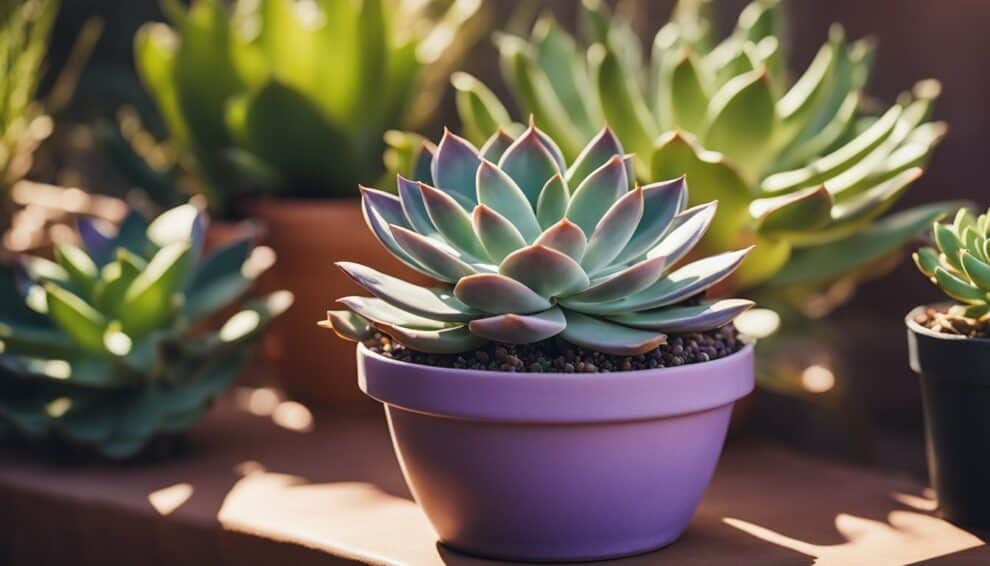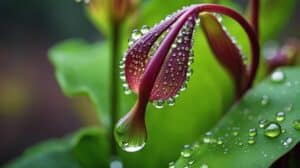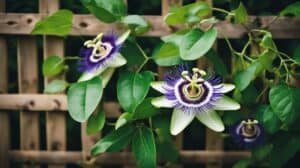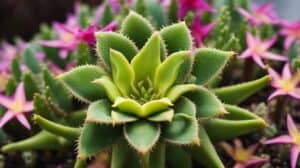Graptopetalum paraguayense, commonly known as Ghost Plant, is a succulent plant that is native to Mexico.
It is a popular choice among gardeners and plant enthusiasts due to its unique, ghostly appearance and ease of care.
In this article, we will provide a comprehensive guide on how to grow and care for Graptopetalum paraguayense, so you can enjoy a thriving and healthy plant.

To begin with, we will discuss the ideal growing conditions for Ghost Plants. These plants prefer bright, indirect sunlight and well-draining soil.
They are also drought-tolerant and can survive long periods without water, making them a great choice for busy gardeners.
We will also cover the best time to plant Ghost Plants and the appropriate pot size for optimal growth.
Furthermore, we will provide tips on how to propagate Graptopetalum paraguayense, which is a simple and cost-effective way to expand your collection.
We will outline the steps for both leaf and stem cuttings, and provide advice on how to ensure successful propagation.
By the end of this article, you will have all the information you need to grow and care for a thriving Ghost Plant.
Getting to Know Graptopetalum Paraguayense
Graptopetalum Paraguayense, also known as Ghost Plant, is a succulent that belongs to the family Crassulaceae.
It is native to Mexico and is a popular choice among gardeners due to its unique appearance and ease of cultivation.
The plant has a rosette shape, with thick, fleshy leaves that are bluish-gray in color.
The leaves are covered in a powdery coating, giving the plant a ghostly appearance.
The Ghost Plant is a small plant, growing up to six inches in height and spreading up to 12 inches wide.
Ghost Plant is a low-maintenance plant that can thrive in a variety of growing conditions. It prefers well-draining soil and bright, indirect light.
The plant is drought-tolerant and can withstand periods of neglect. However, it is important not to overwater the plant, as it can lead to root rot.
Graptopetalum Paraguayense is a great addition to any succulent collection.
Its unique appearance and low-maintenance nature make it an ideal choice for beginners and experienced gardeners alike.
With proper care, the Ghost Plant can thrive and provide enjoyment for years to come.
Essential Care for Ghost Plants

Sunlight and Positioning
Ghost plants require bright, indirect sunlight to thrive. Direct sunlight can scorch their leaves and cause damage.
Place your ghost plant in a location that receives at least four to six hours of bright, indirect sunlight per day.
South-facing windows are ideal, but if that is not possible, you can use artificial grow lights to supplement natural light.
Watering Requirements
Ghost plants are drought-tolerant and do not require frequent watering. Overwatering can lead to root rot and cause damage to the plant.
Allow the soil to dry out completely between watering sessions.
When watering, make sure to water deeply and thoroughly until water drains out of the bottom of the pot.
Soil and Potting Mix
Ghost plants prefer well-draining soil that is slightly acidic. A mix of cactus soil, perlite, and sand is a good option.
Avoid using heavy or clay soils as they can retain too much moisture and cause root rot.
When repotting, make sure to use a pot that is slightly larger than the current one.
Temperature and Humidity
Ghost plants prefer warm temperatures between 60-80°F (15-27°C).
They can tolerate cooler temperatures, but frost and freezing temperatures can damage the plant.
Ghost plants do not require high humidity, but they can benefit from occasional misting during dry winter months.
By following these essential care guidelines, you can ensure that your ghost plant thrives and remains healthy.
Propagation Techniques

Leaf Cuttings
One of the most popular ways to propagate Graptopetalum Paraguayense is through leaf cuttings.
To do this, you will need to remove a healthy leaf from the plant and let it dry for a few days.
Once the leaf has dried, place it on top of a well-draining soil mix and water it lightly.
Over time, the leaf will produce roots and a new plant will begin to grow.
It is important to note that not all leaves will produce a new plant, so it is recommended to take multiple cuttings to increase your chances of success.
Additionally, it is best to take cuttings during the plant’s active growing season in the spring or summer.
Offsets
Another way to propagate Graptopetalum Paraguayense is through offsets. Offsets are small plants that grow from the base of the mother plant.
To propagate using offsets, simply remove the offset from the mother plant and plant it in its own pot with well-draining soil.
Offsets are typically produced by mature plants, so it may take some time before your plant produces them.
However, once they do appear, they are a reliable and easy way to propagate your plant.
Regardless of the propagation method you choose, it is important to provide your new plant with adequate sunlight, water, and nutrients to ensure its success.
With a little patience and care, you can grow a thriving Graptopetalum Paraguayense plant.
Troubleshooting Common Issues

Pest Infestations
Despite being a relatively low-maintenance plant, Graptopetalum Paraguayense can be susceptible to pest infestations.
Common pests that can affect Ghost Plants include spider mites, mealybugs, and scale insects.
To prevent pest infestations, it is important to regularly inspect the plant for any signs of pests.
If an infestation is detected, it is recommended to isolate the affected plant and treat it immediately to prevent the infestation from spreading to other plants.
One effective method of pest control is to use a solution of neem oil and water.
Simply mix one tablespoon of neem oil with one quart of water and spray the solution onto the affected plant, paying particular attention to the undersides of leaves where pests like to hide.
Repeat the treatment every seven to ten days until the infestation is under control.
Rot and Disease Prevention
Graptopetalum Paraguayense is also susceptible to rot and disease if it is overwatered or exposed to damp conditions for an extended period of time.
To prevent rot and disease, it is important to ensure that the plant is not sitting in water and that the soil is well-draining.
If the plant is showing signs of rot, such as soft or mushy leaves, it is important to act quickly to prevent the rot from spreading to the rest of the plant.
Remove any affected leaves and allow the plant to dry out completely before watering again.
In addition to proper watering and drainage, it is also important to ensure that the plant is not exposed to extreme temperatures or direct sunlight for extended periods of time, as this can also contribute to the development of rot and disease.
Frequently Asked Questions

How do you propagate a Graptopetalum Paraguayense?
Graptopetalum Paraguayense can be propagated by stem or leaf cuttings.
To propagate by stem cuttings, simply cut a healthy stem from the parent plant and let it dry for a few days.
Once the cut end has calloused over, plant it in well-draining soil and water sparingly until new growth appears.
To propagate by leaf cuttings, gently remove a healthy leaf from the parent plant and let it dry for a few days.
Place the leaf on top of well-draining soil and water sparingly until new growth appears.
What are the benefits of having a Ghost Plant?
Ghost Plants are low maintenance and easy to care for, making them a great addition to any indoor or outdoor garden.
They also have a unique, ghost-like appearance with bluish-green leaves that can add interest and texture to any plant collection.
How can I prevent my Ghost Plant from becoming leggy?
To prevent your Ghost Plant from becoming leggy, make sure it is getting enough light.
Ghost Plants thrive in bright, indirect light, so make sure to place them near a sunny window or under a grow light.
You can also prune your plant regularly to encourage bushier growth.
What is the typical lifespan of a Graptopetalum Paraguayense?
Graptopetalum Paraguayense can live for several years if given proper care. With the right conditions, they can even live up to 10 years or more.
How often should I water my Ghost Plant?
Ghost Plants are drought-tolerant and do not require frequent watering.
Water your plant only when the soil has completely dried out, usually every 2-3 weeks. Overwatering can lead to root rot and other issues.
What type of fertilizer is recommended for a thriving Ghost Plant?
A balanced, water-soluble fertilizer with a ratio of 10-10-10 is recommended for Ghost Plants.
Fertilize your plant once a month during the growing season (spring and summer) and reduce or stop fertilizing during the dormant season (fall and winter).














